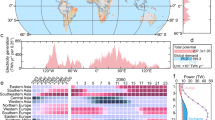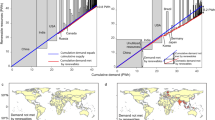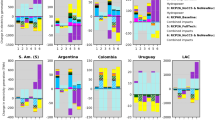Abstract
A rapid global energy transition, including the ramping up of electricity generation from renewables, is needed to limit global warming to 2 °C or 1.5 °C. However, renewable resource endowments vary widely between regions, and renewable electricity is currently mainly used locally. Here we use a global integrated assessment model to explore the implications of renewable electricity trade via a set of planned direct-current-type ultra-high-voltage (UHVDC) transmission lines for global energy transition and climate change. We find that renewable electricity trade across large world regions via the underlying UHVDC interconnection can boost renewable electricity production and reduce 2020–2100 cumulative CO2 emissions from the power sector up to 9.8%. Financial investments in the UHVDC lines are offset in the long term by reduced investments in other electricity-generation options, including nuclear and storage. Finally, we find that renewable electricity trade can substantially reduce air pollutant emissions in importing regions.
This is a preview of subscription content, access via your institution
Access options
Access Nature and 54 other Nature Portfolio journals
Get Nature+, our best-value online-access subscription
$32.99 / 30 days
cancel any time
Subscribe to this journal
Receive 12 digital issues and online access to articles
$119.00 per year
only $9.92 per issue
Buy this article
- Purchase on SpringerLink
- Instant access to full article PDF
Prices may be subject to local taxes which are calculated during checkout







Similar content being viewed by others
Data availability
All scenarios used in this paper are available in the online database https://data.ece.iiasa.ac.at/gei.
Code availability
The code of the MESSAGEix-GLOBIOM model is open source and available at https://github.com/iiasa/message_ix; the model documentation is available at https://docs.messageix.org/projects/global/en/latest/.
Change history
06 November 2023
A Correction to this paper has been published: https://doi.org/10.1038/s41560-023-01409-2
References
McCollum, D. L. et al. Energy investment needs for fulfilling the Paris Agreement and achieving the Sustainable Development Goals. Nat. Energy 3, 589–599 (2018).
Rogelj, J. et al. Scenarios towards limiting global mean temperature increase below 1.5 °C. Nat. Clim. Change 8, 325–332 (2018).
Brinkerink, M., Gallachóir, B. & Deane, P. A comprehensive review on the benefits and challenges of global power grids and intercontinental interconnectors. Renew. Sustain. Energy Rev. 107, 274–287 (2019).
Zhang, Y., Yu, Y. & Ma, T. System optimization of long-distance energy transportation in China using ultra-high-voltage power transmission. J. Renew. Sustain. Energy 10 https://doi.org/10.1063/1.5013177 (2018).
Ultra-high Voltage (State Grid Corporation of China, 2021); http://www.sgcc.com.cn/html/sgcc_main/col2017041259/column_2017041259_1.shtml?childColumnId=2017041259
The Belo Monte Phase II ±800 kV UHV DC Transmission Project is Completed (State Grid Corporation of China, 2020).
GEIDCO, IIASA & WMO Research Report on Global Energy Interconnection for Addressing Climate Change (China Electric Power Press, 2019).
Chatzivasileiadis, S., Ernst, D. & Andersson, G. The global grid. Renew. Energy 57, 372–383 (2013).
Battaglini, A., Lilliestam, J., Haas, A. & Patt, A. Development of supersmart grids for a more efficient utilisation of electricity from renewable sources. J. Clean. Prod. 17, 911–918 (2009).
Abrell, J. & Rausch, S. Cross-country electricity trade, renewable energy and European transmission infrastructure policy. J. Environ. Econ. Manage. 79, 87–113 (2016).
Elliott, D. Emergence of European supergrids–essay on strategy issues. Energy Strategy Rev. 1, 171–173 (2013).
Van Hertem, D. & Ghandhari, M. Multi-terminal VSC HVDC for the European supergrid: obstacles. Renew. Sustain. Energy Rev. 14, 3156–3163 (2010).
Lilliestam, J. & Hanger, S. Shades of green: centralisation, decentralisation and controversy among European renewable electricity visions. Energy Res. Soc. Sci. 17, 20–29 (2016).
Andersen, A. D. No transition without transmission: HVDC electricity infrastructure as an enabler for renewable energy? Environ. Innov. Soc. Transit. 13, 75–95 (2014).
Torriti, J. Privatisation and cross-border electricity trade: from internal market to European supergrid? Energy 77, 635–640 (2014).
Global Electricity Network: Feasibility Study (Technical Report 775) (CIGRE, 2019).
Fürsch, M. et al. The role of grid extensions in a cost-efficient transformation of the European electricity system until 2050. Appl. Energy 104, 642–652 (2013).
Becker, S., Rodriguez, R. A., Andresen, G. B., Schramm, S. & Greiner, M. Transmission grid extensions during the build-up of a fully renewable pan-European electricity supply. Energy 64, 404–418 (2014).
Schlachtberger, D. P., Brown, T., Schramm, S. & Greiner, M. The benefits of cooperation in a highly renewable European electricity network. Energy 134, 469–481 (2017).
Boie, I. et al. Opportunities and challenges of high renewable energy deployment and electricity exchange for North Africa and Europe–scenarios for power sector and transmission infrastructure in 2030 and 2050. Renew. Energy 87, 130–144 (2016).
Timilsina, G. R. & Toman, M. Potential gains from expanding regional electricity trade in South Asia. Energy Econ. 60, 6–14 (2016).
Brand, B. Transmission topologies for the integration of renewable power into the electricity systems of North Africa. Energy Policy 60, 155–166 (2013).
Brancucci Martínez-Anido, C. et al. Effects of North-African electricity import on the European and the Italian power systems: a techno-economic analysis. Electr. Power Syst. Res. 96, 119–132 (2013).
Brancucci Martínez-Anido, C. et al. Medium-term demand for European cross-border electricity transmission capacity. Energy Policy 61, 207–222 (2013).
Chang, Y. & Li, Y. Power generation and cross-border grid planning for the integrated ASEAN electricity market: a dynamic linear programming model. Energy Strategy Rev. 2, 153–160 (2013).
Trieb, F., Schillings, C., Pregger, T. & O’Sullivan, M. Solar electricity imports from the Middle East and North Africa to Europe. Energy Policy 42, 341–353 (2012).
Purvins, A. et al. A European supergrid for renewable energy: local impacts and far-reaching challenges. J. Clean. Prod. 19, 1909–1916 (2011).
Aghahosseini, A., Bogdanov, D. & Breyer, C. A techno-economic study of an entirely renewable energy-based power supply for North America for 2030 conditions. Energies 10, 1171, https://doi.org/10.3390/en10081171 (2017).
Reichenberg, L., Hedenus, F., Mattsson, N. & Verendel, V. Deep decarbonization and the supergrid–prospects for electricity transmission between Europe and China. Energy 239, 122335 (2022).
GEIDCO Research and Outlook on Global Energy Interconnection (China Electric Power Press, 2019).
Online Database (World Bank, 2022); https://databank.worldbank.org/home.aspx
Data and Statistics (International Energy Agency, 2022); https://www.iea.org/data-and-statistics?country=WORLD&fuel=Energy%20supply&indicator=TPESbySource
Robinson D. in International Trade in Sustainable Electricity (ed. Cottier, T.) 54–73 (Cambridge Univ. Press, 2017).
Zarazua de Rubens, G. & Noel, L. The non-technical barriers to large scale electricity networks: analysing the case for the US and EU supergrids. Energy Policy 135, 111018 (2019).
Lilliestam, J. & Ellenbeck, S. Energy security and renewable electricity trade–will Desertec make Europe vulnerable to the ‘energy weapon’? Energy Policy 39, 3380–3391 (2011).
Zhuo, Z. et al. Incorporating massive scenarios in transmission expansion planning with high renewable energy penetration. IEEE Trans. Power Syst. https://doi.org/10.1109/TPWRS.2019.2938618 (2020).
Zhang N. et al. in Analytics and Optimization for Renewable Energy Integration (Eds. Zhang, N., et al.) Ch. 12 (CRC Press Taylor & Francis Group, 2019).
Du, E. et al. Economic justification of concentrating solar power in high renewable energy penetrated power systems. Appl. Energy 222, 649–661 (2018).
Department of Electrical Engineering Power System Planning Decision-making and Evaluation System GOPT Technical Manual (Tsinghua Univ., 2010).
Jiang, H. et al. Optimal planning of multi-time scale energy storage capacity of cross-national interconnected power system with high proportion of clean energy. Proc. China Soc. Electr. Eng. 41, 2101–2114 (2021).
Xiao, J. et al. Quantitative model and case study of energy storage demand supporting clean transition of electric power system. Autom. Electr. Power Syst. 45, 9–17 (2021).
Chen, J. et al. Flexibility improvement evaluation of hydrogen storage based on electricity–hydrogen coupled energy model. Glob. Energy Interconnect. 4 371–383 (2021).
Global Energy Interconnection Backbone Grid Research (GEIDCO, 2018).
Ghods, L. et al. Different methods of long-term electric load demand forecasting: a comprehensive review. Iran. J. Electr. Electron. Eng. 7, 249–259 (2011).
State Grid Economic and Technological Research Institute Grid Planning and Design Manual (China Electric Power Press, 2016).
Batlle, C. & Rodilla, P. An enhanced screening curves method for considering thermal cycling operation costs in generation expansion planning. IEEE Trans. Power Syst. 28, 3683–3691 (2013).
Zhang, N. et al. A bi-level integrated generation-transmission planning model incorporating the impacts of demand response by operation simulation. Energy Convers. Manage. 123, 84–94 (2016).
Liu, Z. Ultra-high Voltage AC&DC Grid (China Electric Power Press, 2013).
Huppmann, D. et al. The MESSAGEix Integrated Assessment Model and the ix modeling platform (ixmp): an open framework for integrated and cross-cutting analysis of energy, climate, the environment, and sustainable development. Environ. Model. Softw. https://doi.org/10.1016/j.envsoft.2018.11.012 (2019).
Fricko, O. et al. The marker quantification of the Shared Socioeconomic Pathway 2: a middle-of-the-road scenario for the 21st century. Glob. Environ. Change https://doi.org/10.1016/j.gloenvcha.2016.06.004 (2017).
Grubler, A. et al. A low energy demand scenario for meeting the 1.5 °C target and sustainable development goals without negative emission technologies. Nat. Energy 3, 515–527 (2018).
van Vuuren, D. P. et al. Energy, land-use and greenhouse gas emissions trajectories under a green growth paradigm. Glob. Environ. Change https://doi.org/10.1017/9781009157940.004 (2017).
Fujimori, S. et al. SSP3: AIM implementation of Shared Socioeconomic Pathways. Glob. Environ. Change https://doi.org/10.1016/j.gloenvcha.2016.06.009 (2017).
Riahi, K. et al. The Shared Socioeconomic Pathways and their energy, land use, and greenhouse gas emissions implications: an overview. Glob. Environ. Change https://doi.org/10.1016/j.gloenvcha.2016.05.009 (2017).
Marangoni, G. et al. Sensitivity of projected long-term CO2 emissions across the Shared Socioeconomic Pathways. Nat. Clim. Change 7, 113–117 (2017).
Johnson, N. et al. A reduced-form approach for representing the impacts of wind and solar PV deployment on the structure and operation of the electricity system. Energy Econ. https://doi.org/10.1016/j.eneco.2016.07.010 (2017).
Sullivan, P., Krey, V. & Riahi, K. Impacts of considering electric sector variability and reliability in the MESSAGE model. Energy Strategy Rev. https://doi.org/10.1016/j.esr.2013.01.001 (2013).
Rogelj, J. et al. in IPCC Special Report on Global Warming of 1.5 °C (eds Masson-Delmotte, V. et al.) Ch. 2 (Cambridge University Press, 2018).
Acknowledgements
We gratefully acknowledge the financial contribution from the project ‘Research on development modes and quantitative assessment of carbon-based resources in life cycle to achieving global carbon neutrality’ (No.SGGEIG00JYJS2200051) to this research. We thank A. Islaam (IIASA) for designing Fig. 1.
Author information
Authors and Affiliations
Contributions
F.G. and B.J.v.R. conceived the research, carried out the analyses and analysed the results. X.C. analysed techno-economic parameterizations of global UHV lines. All authors contributed to writing the manuscript and developing the figures.
Corresponding author
Ethics declarations
Competing interests
The authors declare the following competing interests: this research has been funded by the Global Energy Interconnection Development and Cooperation Organization (GEIDCO), which explores the potential for a global UHV network. S.Z., X.C., C.L., F.Y., H.H. and Y.Z. are employed by the funder of this research and contributed to the preparation of the manuscript. The remaining authors declare no competing interests.
Peer review
Peer review information
Nature Energy thanks Philip Adams, Damien Ernst, Jun Yu and the other, anonymous, reviewer(s) for their contribution to the peer review of this work.
Additional information
Publisher’s note Springer Nature remains neutral with regard to jurisdictional claims in published maps and institutional affiliations.
Supplementary information
Supplementary Information
Supplementary Notes 1–10 (including Supplementary Figs. 1–90 and Tables 1–7).
Rights and permissions
Springer Nature or its licensor (e.g. a society or other partner) holds exclusive rights to this article under a publishing agreement with the author(s) or other rightsholder(s); author self-archiving of the accepted manuscript version of this article is solely governed by the terms of such publishing agreement and applicable law.
About this article
Cite this article
Guo, F., van Ruijven, B.J., Zakeri, B. et al. Implications of intercontinental renewable electricity trade for energy systems and emissions. Nat Energy 7, 1144–1156 (2022). https://doi.org/10.1038/s41560-022-01136-0
Received:
Accepted:
Published:
Issue date:
DOI: https://doi.org/10.1038/s41560-022-01136-0
This article is cited by
-
Self-replenishing Ni-rich stainless-steel electrode toward oxygen evolution reaction at ampere-level
Communications Chemistry (2025)
-
Designing the future electricity spot market with high renewables via reliable simulations
Nature Reviews Electrical Engineering (2025)
-
Fatigue damage reduction in hydropower startups with machine learning
Nature Communications (2025)
-
Globally interconnected solar-wind system addresses future electricity demands
Nature Communications (2025)
-
Wildfire and power grid nexus in a changing climate
Nature Reviews Electrical Engineering (2025)



